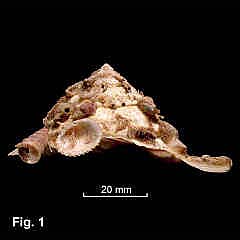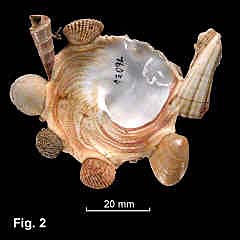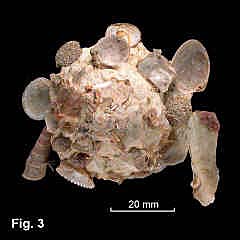|
|
|
|
|
Xenophora peroniana Iredale, 1929 Description: Shell of moderate size and moderate elevation for family; whorls convex. Whorl surface very rough, with coarse shells and rock fragments attached to all whorls, covering more than 50% of surface. Base strongly concave in overall shape, formed by a narrow peripheral flange and flat basal whorl. Umbilicus absent in adults, narrowly open in juveniles. Colour fawn, base with curved chocolate-brown lines, columellar and lip callus white. Operculum corneous. Size: Up to 41 mm high, 54 mm wide (shell only, excluding appendages). Distribution: Restricted to eastern Australia; Capricorn Channel, Queensland, southwards to eastern Bass Strait. Habitat: Subtidal, 37-457 m. Common. Comparison: X. peroniana is the most common species in eastern Australia. It is of medium size, and the only species with no umbilicus. X. pallidula is larger, with umbilicus open, and attaches large shells over the whole surface. X. solarioides is like X. pallidula but is the smallest of the group in NSW. X. gigantea and X. indica are both large, lightweight shells with the umbilicus open and a wide basal flange. X. gigantea attaches objects sparsely to all whorls, but X. indica attaches only fine material to the early whorls. Remarks: This species attaches pebbles and bivalves shell most frequently, but also gastropods, worm tubes and corals, of size about equal to the whorl height. Figs. 1, 2, 3: 4046-1 4045-1 4044-1 Off Botany Bay, NSW (C.076034) |


